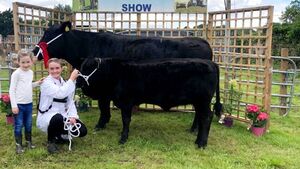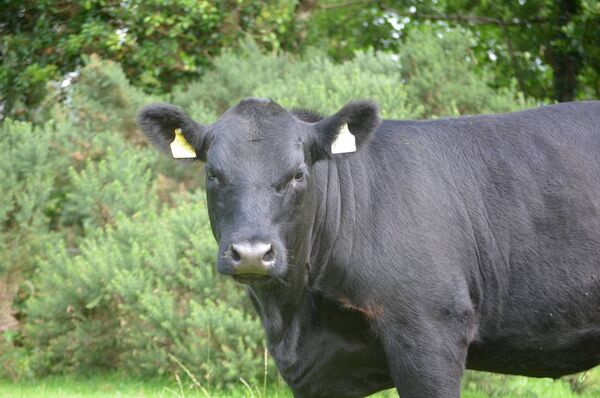The perfect cow for the mountain farm

Prize winning Angus cattle being shown by Grainne Brennan and her aunt, Siobhan Brennan.
If I was to be a farmer and I was told I could pick just one breed of cattle to have on my farm, I would pick the Aberdeen Angus. They are a little old-fashioned but they are warm and easy; the perfect breed for the Ox Mountains.
My father loved these cattle. For him they were trouble free and utterly predictable; easily calved and easily fed. I remember him saying once, when he saw a bunch of Aberdeen Angus weanlings in a field, that they were "like buttons on a waistcoat".
The Aberdeen Angus is a Scottish breed of beef cattle. They were forged from cattle native to the counties of Aberdeen, Banff and Angus in north-eastern Scotland. The cattle have been exported to many countries around the world and today there are large populations in Australia, Canada, New Zealand, South America and the United States. In the US, the breed has developed into two separate and distinct breeds, the American Angus and the Red Angus. In some countries the breed has now been bred to be taller than the native Scottish stock.
Aberdeen Angus cattle have been recorded in north-eastern Scotland since at least the sixteenth century. For some time before the 1800s, the hornless cattle in Angus were called Angus Doddies, while those in the historic province of Buchan (later part of Aberdeenshire) were known as Buchan Humlies. Both "doddie" and "humlie" means “polled”. Polled animals are without horns, a dominant and very useful trait in bovine genetics.
In 1824, William McCombie of Tillyfour, later the Member of Parliament for West Aberdeenshire, began to improve the stock and is regarded today as the father of the breed. The breed was officially recognised in 1835 and a society was formed in 1879. The cattle became commonplace throughout the British Isles in the mid-twentieth century. The Irish Angus Cattle Society was established in 1967, having as its primary objective the development and improvement of the breed in Ireland.
Because of their native environment, the cattle are very hardy; they can survive the Scottish winters, winters that are often very harsh with frost, snowfall and repeated storms. Cows weigh about 550 kilograms (1,210lb) and bulls some 850 kilograms (1,870lb). Bulls may be crossed with dairy cows to produce a reasonable beef calf.
The Angus reach maturity earlier than some other native British breeds such as the Hereford. The Aberdeen Angus is reared for beef and the meat can be marketed as superior due to its marbled appearance. This has led many markets, including Australia, Canada, New Zealand, South Africa and the United Kingdom, to adopt it into the mainstream.
The Irish Angus Cattle Society was responsible for introducing AI (artificial insemination) to the breed and for later acquiring Canadian bloodlines which radically improved the conformation of the Angus breed. It is also the first breed society in Ireland to introduce a breed specific beef scheme – the Certified Irish Angus Beef Scheme. The society has been responsible for the improvement and consequential revival of the breed as it faced down the challenge of imported continental beef breeds. Irish Angus is now firmly established as the top beef breed in Ireland and quality pedigree Angus stock are again in demand from both commercial farmers and pedigree breeders at home and abroad.

This piece was inspired by the fact that a neighbour of mine has a small herd of pedigree Abeerdeen Angus cattle. John Brennan explains his connection to the breed, a connection that happened quite by accident, through the persistence of his young daughters.
“I always had an interest in cattle and in showing cattle at various local shows," said John. "These were commercial cattle, born and bred for performance. Attending such shows with these cattle was a family affair and if the truth be told, the days out together were as important, if not more important, than winning prizes.”
In reply to the question as to how he moved from commercial to Abeerdeen Angus cattle, John said: “It was my girls really. They began to see other breeds at the various shows and little by little they fell in love with the Angus. I was eventually persuaded - they are hard to resist - and so we ended up getting our first two Angus heifers about 12 years ago, Owenmore Maizy and Owen Noeleen, from a breeder in Ballymote.”
If you were to think that this loveable, docile breed could just be popped up on a trailer of a Sunday morning and taken to a show to win top prizes, you would be sorely mistaken. Such work is painstaking and protracted. John gives some idea of what is involved in getting an animal to show standard.
“Work starts a few days after a calf is born. From then on, a lot of the work goes on behind the scenes, which includes washing, walking and grooming. The grooming is done by my son Niall and myself. We are then more than happy to let the girls into the show ring where they are now joined by Niall's daughter Grainne. She has taken to the whole thing like a duck to water and now enjoys the fun and friendships that we ourselves love so much."
As I finished chatting to John Brennan, I asked him to sum up his thoughts on his Aberdeen Angus cattle; what was it about them that made them important enough for him to invest his time and money? His reply wasn’t quite what I was expecting but then again, it didn’t really surprise me either.
“Funnily enough, it’s not so much the breed, lovely and all that they are, but the time spent with family that means the most to me. Yes, we won prizes; rosettes, trophies and prize money and over the years we had some great achievements but other times, we can home with nothing to show for all our efforts.”
Reassuring himself that his, by now adult, daughters weren’t listening, John finishes off by saying, “The time spent as a family was always the big win for me.”
In a funny way, it seems the Aberdeen Angus were just the catalyst in the Brennan family tradition of showing prize cattle - the thing that brought them together as a family each weekend.
If my father was alive today, he would likely be continuing his tradition of going for a Sunday afternoon cycle. While spinning through Cloonacool, he would spot the Aberdeen Angus weanlings on John Brennan’s Ox Mountain farm and he would surely hop off his bike to admire them, lined up in the centre of the field “like buttons on a waistcoat”.





